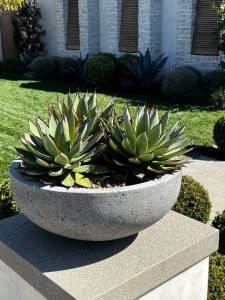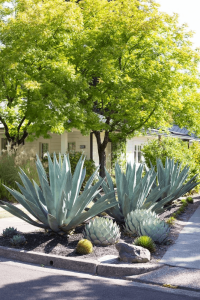Is a charming succulent plant native to Mexico, which is loved by gardening enthusiasts for its unique leaves and flowers. Belongs to the Agavaceae family and is a small agave known for its compact growth habit and beautiful flowers. During cultivation, different environmental conditions have a significant impact on the growth of Agave Geminiflora.

Agave Geminiflora
Effect of light conditions
The light requirement of Agave Geminiflora is one of the key factors affecting its healthy growth. In the natural environment, this plant usually grows in semi-arid or arid areas and is accustomed to strong sunlight. Proper light is essential for the growth of Agave Geminiflora.
Sunny environment: Shows the best growth state in an environment with sufficient light. They need full sun or at least 6 hours of direct sunlight per day to maintain healthy leaf color and shape. Adequate light can promote photosynthesis of plants, increase their growth rate, and help plants establish a strong root system. In a sunny environment, the leaves of Agave biflora usually show a brighter green color and a more compact rosette structure.
Indirect light environment: In indoor cultivation, light conditions are usually limited, and Agave biflora may need indirect light or the use of plant growth lights to supplement the light. Although the plant can survive in lower light conditions, its growth rate will be slower and the color of the leaves may become duller. At this time, ensuring that the plant is exposed to as much light as possible and rotating the plant regularly to ensure even light exposure is an effective way to improve plant health.
Low light environment: In an environment with insufficient light, the growth of Agave biflora will be significantly inhibited. Long-term lack of sufficient light will cause the leaves of the plant to become longer and thinner, lose their original compactness, and may grow too long. The color of the leaves may also become pale or yellow, and the overall health of the plant will be significantly reduced. For environments with long-term insufficient light, increasing light or using plant growth lights will be key measures to improve the condition of the plant.
Effect of temperature on Agave biflora
Is native to tropical and subtropical regions and has a certain adaptability to temperature. They thrive in warm environments, but have limited tolerance to extreme temperatures.
Warm Environment: Agave biflora performs best in warm environments. The ideal growing temperature range is usually between 20 and 30 degrees Celsius. Within this temperature range, the plant grows faster, has bright leaf colors, and is in good overall health. Within this temperature range, Agave biflora is able to photosynthesize and grow normally, maintaining a stable plant state.
Extreme Heat: Although Agave biflora can adapt to hot environments, sustained extreme heat may cause stress to the plant. When the temperature exceeds 35 degrees Celsius, the plant may experience dry, discolored, or scorched leaf edges. In extremely hot environments, ensuring that the plant has adequate water and providing appropriate shade or ventilation can help mitigate the effects of high temperatures on the plant.
Cold Environment: Agave biflora is less tolerant of cold temperatures. When the temperature is below 10 degrees Celsius, the plant may suffer from frost damage, and the leaves may turn yellow, become soft, or wilt. In cold environments, Agave biflora should be moved indoors or to a warm area to protect the plant from freezing. In addition, watering should be reduced in cold seasons to prevent roots from freezing and rotting.
Influence of soil conditions
Soil type and drainage have an important impact on the growth of Agave bispinosa. Since Agave bispinosa is native to arid environments, they have high requirements for soil drainage.
Well-drained soil: Agave bispinosa grows best in well-drained soil. The ideal soil is usually a mixture with a lot of gravel and perlite to ensure that water can be drained quickly. Well-drained soil can effectively avoid waterlogging at the roots, thereby reducing the risk of root rot. Using a soil mixture designed specifically for succulents and Agaves can provide the plant with an ideal growing environment.
Heavy soil: The growth of Agave bispinosa will be significantly inhibited in heavy or poorly drained soil. Heavy soil easily leads to waterlogging at the roots, which may cause root rot and other diseases. In this soil condition, it is crucial to improve the drainage of the soil. You can improve the soil structure and drainage by mixing in sand or perlite.
Soil pH: Agave biflora thrives in neutral to slightly acidic soils, with soil pH generally ranging from 6.0 to 7.0. Within this pH range, the plant is better able to absorb the nutrients it needs. If the soil pH deviates from this range, the soil pH can be adjusted by applying an appropriate soil conditioner to ensure that the plant can grow normally.
Effect of Humidity on Agave biflora
Humidity also has a significant impact on the growth of Agave biflora, especially in indoor environments where humidity conditions may be quite different from the plant’s native environment.
High Humidity Environment: Agave biflora may experience some problems such as mold or mildew on the edges of leaves in environments with high humidity. High humidity environments may cause the evaporation of water on the leaves of the plant to slow down, increasing the risk of pathogens. To combat this problem, good ventilation should be maintained around the plant, and the plant should not be left standing or damp for long periods of time.
Low Humidity Environment: Agave biflora is native to arid environments, so they have a strong ability to adapt to low humidity. Low humidity environments generally do not have a noticeable negative impact on the plant, but overly dry environments may cause the edges of the leaves to dry out. To improve the impact of low humidity on plants, you can spray regularly or use a humidifier to increase the surrounding humidity.
Indoor environment: In indoor environments, humidity is usually low. In order to maintain a suitable humidity level, it is recommended to spray the plants regularly, especially in the dry winter. In addition, using a humidifier or placing the plant on a moistened tray is also an effective way to increase humidity.
Tips for caring for double-flowered agave
Properly adjust environmental conditions: Understand the growth needs of double-flowered agave and make appropriate adjustments based on environmental conditions. Ensuring that the plant receives adequate light, maintains a warm growing environment, and uses well-drained soil are key factors in ensuring healthy plant growth.
Regularly check the status of the plant: Regularly check the leaves, roots, and soil conditions of the double-flowered agave to detect and solve potential problems in a timely manner. Pay attention to changes in leaf color and texture, check soil moisture, and ensure that the plant is not disturbed by pests and diseases.
Adapt to different environments: Choose the appropriate cultivation method according to environmental conditions. If you grow double-flowered agave indoors, you can use plant growth lights and humidifiers to simulate the natural growth environment of the plant. If growing outdoors, make sure the plant has access to the right amount of light and water, and take the necessary steps to cope with extreme weather conditions.

Agave
Is a plant that is sensitive to environmental conditions, and its growth status will show significant differences in different environments. Factors such as light, temperature, soil, and humidity have an important impact on the healthy growth of plants. By understanding these influencing factors and taking appropriate management measures, you can provide an ideal growth environment for Agave biflora, thereby maintaining the health and beauty of the plant. Whether growing indoors or outdoors, reasonable adjustment of environmental conditions and regular care can enable Agave biflora to show the best growth state, bringing lasting pleasure and sense of accomplishment to gardening enthusiasts.
Post time: 08-26-2024




